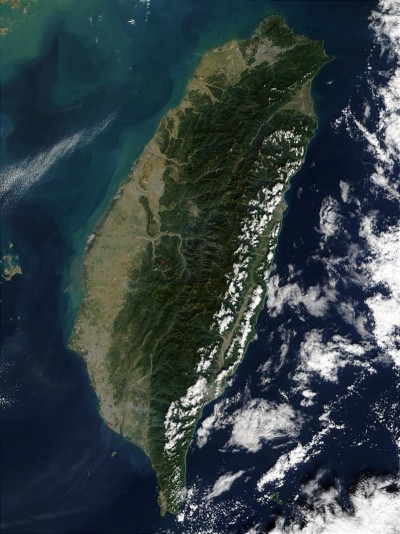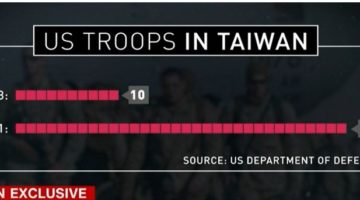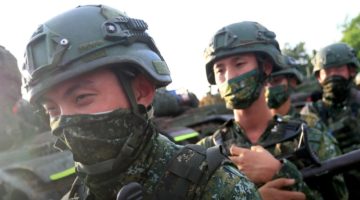Crédits Photos © NASA
With the protests in Hong Kong reminding the world how democracy challenges the leadership of the PRC, Taiwan remains a clear reminder that it is possible to be both Chinese and democratic.
But for it to remain democratic, it needs to remain free. And that requires the successful defense of Taiwan, and this will not happen in the face of extensive PRC modernization without modernizing Taiwanese defenses.
Taiwan is working to do so, but US and Europe have not been very forthcoming in aiding in the effort.
Twenty years ago, President Clinton signed the Taiwan Policy Review (TPR). According to this TPR, the US was to assist in the defense of Taiwan by providing Taiwan with arms of a defensive character and help in matters of national defense.
But what is the state of play in 2014?
Is a New TRP Necessary?
A group of 29 Congressmen headed by the House of Representatives Foreign Affairs Committee Chairman Edward Royce (R-CA) have called on Secretary of State John Kerry to launch major new Taiwan policy review .
At the end of September, the Project 2049 Institute held at the U.S. Representatives’ Rayburn House Office Building (Washington D.C.) a conference called “The Taiwan Policy Review at 20 Years: Assessing the Future of U.S. Taiwan Policy”.
Among the panelists, Robert Suettinger and Ambassador Winston Lord gave their visions of the Taiwan-U.S. relationship and its future.
The relationship between the two states is on the “unofficial” level and the panelists argued that this needed to remain so.
Dr. Shen Lyushun, the representative of the Taipei Economic and Cultural Representative Office in the U.S. – in effect the Taiwan’s ambassador – stated, “officially, we have no-official relations but, non-officially, we have official relations.”
Even if there is a risk of misunderstanding, even if there is “strange trees” that cannot be explain, Lord prefers to keep the relation in a “twilight zone,” to avoid attention and major concerns in the U.S.-China affairs.
Randall Schriver, President of The Project 2049 Institute, cautioned that this position should not lead to a frozen status in terms of aid and assistance.
The Obama Administration should deepen relations, the arms sales process is currently “absolutely broken,” and more than three years have passed since the last arms sales notification.
“Legitimate security requirements are not being met.”
In effect, are the relations frozen?
Risks From the Obama Administration’s Self-imposed Limits on Arms Sales
The Obama administration has increasingly showed a hesitant stance in selling weaponry to Taiwan.
Deliberations about whether to sell the F-16 C/D has been concluded in September 2011 by the decision to upgrade Taiwan’s 145 F-16 A/B, clearly a political compromise vis-à-vis China. 1
Unlike the “quasi-alliance” under the Bush administration , the Obama Administration seems to have frozen relations. 2
“The United States retains considerable freedom of action when it comes to abiding by the [Taiwan Relation Act] and selling necessary arms to Taiwan.
Yet the Obama Administration has demonstrated unnecessary restraint in its Taiwan arms sales decisions, despite having ample justification for positive consideration.” 3
In the same vein, the delivery of two Perry-class frigates is likely to be postponed until 2016, instead of 2015 as originally planned.
The purpose of this request was the replacement of the two aging Knox-class frigates.
Since the inauguration of the Obama administration in January 2009, only one Letter of Request (LOR) from Taipei has been accepted.
“We are now in the longest period since 1979 in which the U.S. has not sold weapons to Taiwan, and there is little prospect of any new arms sales in the coming 12-18 months,” explained Rupert Hammond-Chambers in Congressional testimony. 4
Whereas Washington must be proactive, imaginative with a long-term vision, in reality, it has left the U.S.-Taiwan “relations essentially on autopilot” whereas China improved its military arsenal, a genuine tool for “reunification” since China has never renounced the unilateral use of force in this purpose. 5
Beyond the Chinese ongoing development of a “fifth-generation” aircraft, the J-20 in the short-term and the J-31 in the medium-term, there is indeed a high probability that the country will become the first foreign customer of the S-400 Triumph, the Russian latest double-digit generation of SAM.
This system will considerably reinforce the Chinese arsenal in the surface-air-missile segment, currently composed of Russian S-300 and indigenous HQ-9 in order to deny the Taiwanese airspace dominance.
At present, land-based mobile air defense missile systems can reach only a northwestern strip of the country.
The S-400 will be able to cover the entirety of Taiwan territory, a game-changer affecting the ability to defend Taiwan.
Taiwanese Defense: Trying to Meet the Challenges
The ROC seems to understand the threat posed by technologies’ improvement in the mainland.
Indeed, Taiwan is seeking to provide his own response, through the increase of the military budget in order to finance indigenous ships, fighters and missiles systems.
While the defense budget of the island used to be in decrease, from 24.3% in 1994 to 16.2% in the 2013 fiscal year according to Craig Murray, the government proposed a defense budget for 2015 in growth of $330 million at $10.4 billion, compared to the 2014 budget.
Increased spending, in the context of overall military personnel reductions and the implementation of an all-volunteer force, will be mainly allocated for investment with emphasis on the Air Force and the Navy.
Indeed, as explained in the last National Defense Review (NDR – 2013), the defense of the homeland goes through the need to control the Taiwan Strait.
“The ROC Armed Forces follows guidelines of defensive operations in learning the enemy’s route of approach, and utilizes temporal and spatial factors in seizing advantageous tactical positions, where it can utilize joint capabilities and gather superior forces and firepower for joint interdiction and striking the enemy when transiting across the Taiwan Strait.” 6
Emphasis is being put on the Air and Naval components of Taiwan’s forces.
A report, whose details will be released in November, will outline plans to build new destroyers, frigates, corvettes and submarines in a 20-year modernization program. As detailed by Defense News, the US and French-built warships – Perry, Knox, La Fayette and Kidd – as well as the U.S. and Dutch-built submarines – aging Guppy II for the training purpose and Zwaardvis – will need to be replaced.
But the originality of this plan is not here.
Indeed, the report advocated for a huge improvement of indigenous capabilities. Even if U.S. companies could be allowed to supply of many systems, none of the new surface ships will be built overseas.
This stance was already manifest in the last NDR:
The [Ministry of National Defense] will prioritize the indigenous development of key technologies and weapon systems. In addition, foreign procurement of advanced weapon systems will be defensive in nature, beyond indigenous development capability and purposed to replace outdated systems, so as to build a modernized force required by our national defense.” 7
As Defense News explained, “Taiwan will rely on the combined efforts of its Ocean Industries Research and Development Center for design, the Taiwanese militaryrun Chungshan Institute of Science and Technology (CSIST) for systems and integration, and the Taiwanbased China Shipbuilding Industry Corp. for construction.”
Beyond the creation of national jobs and skills, this plan reduces reliance on restrictive arms exports from U.S. It comprises four 10.000 tons destroyers, 10 to 15 3.000 tons catamaran frigates and amphibious transport ships.
This planning will improve the scale of indigenous shipyard who currently produced the Tuo River, first vessel in a new class of 12 catamaran corvettes, heavily armed (16 anti-ship missiles), the commissioning being expected in the first half of 2015.
The Case of Diesel Submarines
Diesel submarines are a crucial element for Taiwanese defense. The stance of Taipei on the acquisition of four-to-eight diesel submarines seeming not still definitive on how to build these key assets.
Although the spokesperson for Taiwan’s defense ministry, Major General Luo Shou-he, explained that his country planned a local submarine program in order to show its determination to own this capability Taipei is still open to cooperation with US and European companies with technical assistance and the provision of certain types of components by U.S. industry.
Submarines’ renewal was an old-hat subject in the island, especially related with the U.S.
In 2001, under President George W. Bush and through an operation named Sea Star Project, U.S. proposed to build new conventional subs for Taiwan as part of a Foreign Military Sales (FMS).
But the project became dead in the water after the U.S. Navy estimated the cost around $10 billion.
Taiwan cannot wait any longer a response of the European or U.S. governments on this subject as stated by Andrew Hsia, Taiwanese deputy defense minister.
Despite the research and development and others obstacles it may face, this sharp resolution could pay off, Mark Strokes, Project 2049 Institute’s executive director, explained, “I don’t have any doubt they will succeed.”
Beyond showing a clear determination to develop this capability, this step forward could be a goodwill gesture toward the U.S. Indeed, in the past, this approach with the development of the Indigenous Defense Fighters (IDF) Ching Kuo in 1988, was a success and paved the way for the F-16 sales in 1992, explained a military source.
“If we could develop our own indigenous submarines until a certain level, the US could then consider technology transfer,” added this source
This logic is also reflected in the missile area, Taiwan is planning to spend $2.5 billion in the next nine years to acquire anti-missile systems.
For this surface-to-air missile system, the defense Minister Ming Yen aiming to purchase locally-made Tien Kung 3 (Sky Bow 3) in order to replace the aging Hawk missile systems in the Taiwanese Army.
A naval version would also be develop, in order to prevent an U.S. refusal in providing the RIM-161 Standard Missile 3 (SM-3).
This anti-missile system developed since 1996 by Taiwan’s Chungshan Institute of Science and Technology, is designed to intercept China’s cruise missiles and counter the possible threats made by the J-20.
Beyond this proactive policy, Taiwan maintains a strong presence at sea, considering recently stationing armed vessels permanently on Itu Aba/Tai Ping, the only island in the Spratlys large enough to receive a port, currently under construction.
Expected to be completed in 2015, this installation will accommodate a 3,000 tons naval frigate or coastguard cutters.
The Japanese Card
Although history didn’t constitute Japan as prima facie ally to Taiwan, early Taiwanese nationalists being resistance fighters against Japanese colonial rule, “the democratic discourses bring Japan and Taiwan closer by highlighting a value-based identity” Japan was not the lone democracy in the region since the 90’s democratization of the island under Chiang Ching-kuo then Lee Teng-hui. 8
Current and potential threats could accentuate the path toward closer relationship between the two states.
A nuclear capable North Korea, in terms of warheads and missiles, will undoubtedly create closer defense ties. And this cooperation is already ongoing.
For instance, during a yet again North Korea long-range missile test, Taiwan’s new ultra high frequency (UHF) radar system has tracked the missile and provided a warning to the U.S. and Japanese warships.
In terms of potential common menace, Chinese S-400 will cover the entirety of Taiwan territory as aforementioned, but also the Senkaku/Diaoyu Islands, a key focus of the territorial dispute between China and Japan, giving China increased advantage in its ongoing dispute. This element could be yet again lead to deeper the relation between Taiwan and Japan.
This move could be supported by recent developments in the Japanese arms exports’ rules, welcomed by the former president Lee Teng-hui, who supported Japan for a collective self-defense.
Moreover, Lee Teng-hui agreed with the idea of having a Japanese version of the TRA in order to improve the friendship between the two countries In the same vein, the actual President, Ma Ying-jeou, has appeared recently proud of the unofficial relations between Taiwan and Japan, especially through a fisheries pact signed in April 2013, which reduced disputes and brought “peace to the shared ocean areas of (our) two countries, which did not come easily.”
Ed Timperlake has noted that the PRC is driving the two greatest naval powers of the 20th century together — the US and Japan. Perhaps the PRC is doing something similar with regard to Japan and Taiwan.
The US Opportunity
The indigenous way taken by Taiwan could, at a certain level, be advantageous for the U.S. and the Pacific allies as well in terms of providing new technologies.
For example, the Hsiung Feng III (HF-3), a supersonic anti-ship missile using ramjet technology, could improve the action of U.S. Navy in terms of speed and range. Whereas the Harpoon class high-subsonic anti-ship missile flies around Mach 07-0.8 (about 530 mph, 240 m/s), the HF-3 reaches Mach 2 (about 1,500 mph, 680 m/s).
In addition, the HF-3 has a larger range than the Harpoon, 300 km/186 miles opposed to 124 km/77 miles for the latter In this case, and more generally in the area of missiles systems, the Taiwanese technology could fill a gap in the U.S. arsenal.
It is not a one way street, but for the US it is crucial to demonstrate that there is a functioning street shaping capabilities to deal with the PRC.
There is a clear danger posed by Obama Administration’s slow rolling of Taiwan on arms exports, namely the PRC could see this as part of a broader global policy of hesitation and uncertainty seen in Ukraine, the “red line” in Syria, the response to Benghazi, etc and misinterpret what the US would do in the case of PRC aggression against Taiwan.
In other words, arms sales to Taiwan is no longer a parochial issue it is part of a broader deterrence policy towards the PRC and its global policies.
A clear statement of an innovative way forward is to move past the F-16 to the F-35B which fits the Taiwanese defense needs well.
As Lt. General (Retired) Deptula has commented: “There is not a better place for utility of F-35B than in the defense of Taiwan.”
The ROC Air Force now includes less than 350 capable aircraft, the 87 F5E/F Tiger being outperformed by moderns’ Chinese aircraft. This includes Mirage 2000-5, F-16A/B and F-CK-1A/B Ching Kuo IDF.
But, as result of the freeze of new sales by U.S., a “fighter gap” in favor of PRC has clearly happened. And a significant one affecting the ability to defend Taiwan. 9
Even though Taiwanese pilots received a much better training than Chinese pilots, they risk to be surpassed by the Chinese quantity.
As Rick Fisher, a leading expert on the PRC military said:
Washington gains nothing by delaying the sale of new F-16s to Taiwan.
Selling new F-16s with modern subsystems will more quickly prepare the Taiwan Air Force for what it really needs, a version of the fifth-generation F-35.
Depending upon the equipment package, upgrading Taiwan’s early model F-16s can sustain a low level of parity, but that will not keep pace with a Chinese threat that grows every day.
If the U.S. persists in not providing top of the line fighters to Taiwan, the only other option for ROC would be to engage a huge development of cruise and ballistic missiles development and production to become an armed island able to launch upon attack a massive missile response.
Is this in the US’s own interest?
A F-35B fleet will ensure a Taiwanese aerial response capability by eliminating problems related to airfield damage repair (ADR). This sensitive aptitude is actively maintained, together with the possibility for fighter jets and early warning aircraft to land, refuel and take off from an highway, as major exercises recently showed.
As stated by Robbin Laird, Edward Timperlake and Richard Weitz, the reason of the relevance of F-35B is simple:
An F-35B can stand strip alert on any long runway, U.S. or allied […].
As a crisis situation develops, the F-35Bs can be remotely placed in hardened bunkers and revetments and thus become a significant deterrence asset that can instantly sortie into combat and return to gas and go again and again.
By using a detachment of F-35Bs, the issue of enemy runway area denial and need for rapid runway repair does not become a show stopper to ops-tempo both offensively and defensively.
This is a core reasons why Singapore has purchased the F-35 and why states like Israel and Taiwan are interested as well. 10
And the F-35 was designed for a double-digit SAM environment, its arrival on the island thus attenuating the threat of Chinese’s S-400 to the defense of Taiwan.
At a regional scale, these achievements should foster the insertion of the ROC in the security Pacific appraoch of the U.S. Through the commonality of spare parts and the supply chain of the F-35, U.S., ROC and other countries of the Region (Australia, Singapore, Republic of Korea, Japan) could share common operational and support capabilities.
Further, from a geographic perspective, Taiwan is at the center of any actions between China and the United States. The island is situated at the crossroads between the East and South China Seas, one of the world’s most heavily trafficked sea lines.
As described by Ian Easton,
Not only critical for bottling the Chinese navy up inside the first island […] Taiwan also plays a leading role in the air.
With China fielding ballistic missiles for targeting U.S. aircraft carrier groups in the Western Pacific and Andersen Air Force Base on Guam, Taiwan’s defenses matter more now than ever.
Chinese missiles would have to go through Taiwan’s airspace on the way to their targets.
With the right combination of high-powered ballistic missile defense radars and interceptors, Taiwan can serve as a shield to protect deployed American forces during a contingency.
Therefore, as stated during the September conference by Shirley Khan, Specialist in Asian Security Affairs, the arms sales not damages U.S.-Taiwan relations, they improve this relation and “serve as a political link in securing American support”.
From this perspective, an effective ROC’s submarine force able to conduct routines patrols missions in China Seas, with improved F-35 fleet, advanced C4ISR capabilities, an unofficial intelligence exchange with the U.S. and Japan about China, and the aptitude to provide ballistic missile early warning, should transform Taiwan in a cornerstone of the U.S. strategy in the Pacific.
The PRC Response
In the past, as explained in a paper of the Project 2049 Institute:
Beijing seems to have responded most vigorously immediately following official Executive Branch notification to Congress under [Section 36(b) of the Arms Export Control Act (AECA)].
This is the only time in the process during which public acknowledgement of an arms sale is required by law.
Other policy approvals, whether under the old Arms Sales Talks framework or via releases of Price and Availability (P&A) data for specific programs, do not necessitate public, on-the-record confirmation.
In other words, Beijing appears to respond most intensely to public confirmation of a security assistance program, presumably due to the political boost that it provides to Taiwan.” 11
The responses from PRC vary in a wide range of actions, from diplomatic protest, i.e. recall or withdrawal of the PRC ambassador in Washington or breaking off talks in certain domains, to public protest through mass media.
Retaliation against U.S. economic interests in China could be limited by externals incentives: the necessity to preserve the image of the country as a reliable trade partner vis-à-vis the rest of the world, and the capability for the U.S. to sue China in front of the World Trade Organization, which disposes a jurisdiction in this domain and could impose binding decisions in order to end the infringement.
Finally, Beijing could use implicit threats to release sensitive missile or nuclear technology to Iran or North Korea in retaliation of U.S. arms sales to Taiwan.
However, this choice would be criticized not just by U.S. but also by the majority of the countries, the international community being concerned by the proliferation of weapon of mass destruction.
Eventually for Beijing, this path will be excessively expensive compared to the object of these retaliations, the price to win being worst than the profit of these sanctions. 12
As largely debated during the September conference, the skill of the U.S. officials to keep these subjects in the twilight zone will prevent this kind of retaliations to China, actions which, in the past, have not been long lasting.
For the PRC, every arms sale to Taiwan reduces the incentive of bargaining in order to plan the return of the province in the mainland.
For Beijing, these sales are parts of the “creeping independence” strategy, which involves “small movements toward a long-term objective without ever taking an action large enough to justify a hostile response” but are regarded by China “as steps in a process that might end in constitutional change and a formal declaration of independence.” 13
Quite the contrary, while recent history has proven that Beijing’s reprobations appears to be focused on the supply side, the U.S., rather than on the demand side (Taiwan), these sales should sustain peace development on both sides of the Strait, Taiwan feeling more confident in engagement with PRC, not being in an unbalanced position, and preventing it from any further deterioration.
An illustration can be found in the F-16 sales’ announcement in 1992, at the time, a highly comparable sensitive’s issue that the today F-35 sales could be:
In the immediate afterglow of the U.S. F-16 announcement, cross-Strait ties also began to warm considerably.
A month after the announcement, and thus confident of U.S. backing, representatives from Taiwan met in Hong Kong with their counterparts from China.
There, the two sides achieved a major breakthrough in agreeing to put aside differences over the definition of “One China.”
Later termed the “1992 Consensus,” the meeting paved the way for the senior representatives of the two sides to also meet in Singapore in 1993.”
Even if the link is difficult to determine for certain, at least, the F-16 sales “did not have any apparent negative effect on cross-Strait rapprochement.” 14
Conclusion: Be Ready for the Worst to Ensure the Best
Nobody can deny the rise of tensions in East and Southeast Asia, most of the neighbors of China being on alert about its assertiveness in territorial claims, especially Japan, South Korea and Vietnam.
But in spite of this posture, the cross-Strait relations are currently relatively peaceful.
Since the 2008’s election of the KMT’s candidate Ma Ying-jeou and his policy of the “Three No’s” (no unification, no independence, no use of force), and his strategy of “economy first, politics later; easy things first, difficult things later”, atmosphere between the two states has warmed.
About ten official talks have been held and some twenty agreements were signed, including the Economic Cooperation Framework Agreement (ECFA) in June 2010 and the Cross-Strait Service Trade Agreement (CSSTA) in June 2013 – but still not ratified by the Taiwanese legislature – about free trade and liberalization of service sector. 15
However, as stated by a Taiwanese Proverb, “Something that looks good does not necessarily taste good.”
With the military option for reunification on the table until China officially renounces to use it for recover the 23rd Chinese province, Taiwan has to preserve and increase its military capabilities.
From this perspective, U.S. arms sales to Taiwan, beyond to be an indicator of the American commitment to preserve the stability in the Asia-Pacific region, will be the best possible way of ensuring the preservation of the lone capability which, in last resort, will guarantee the survival of Taiwan as free and democratic state.
First publication of this article: SLDinfo.com












